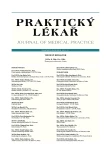Long-term prognosis of patients hospitalized with acute heart failure
Authors:
K. Zeman 1; L. Pohludková 1; Lucie Nováková 1; L. Dušek 2; S. Littnerová 2; R. Miklík 3; J. Pařenica 3; J. Špinar 3; J. Jarkovský 2
Authors‘ workplace:
Interní oddělení Nemocnice ve Frýdku-Místku, p. o., Primář: MUDr. Petr Vítek, PhD.
1; Institut biostatistiky a analýz, MU Brno, Ředitel: doc. RNDr. Ladislav Dušek, PhD.
2; Interní kardiologická klinika Lékařské fakulty MU a FN Brno, Přednosta: prof. MUDr. Jindřich Špinar, CSc.
3
Published in:
Prakt. Lék. 2012; 92(8): 465-469
Category:
Of different specialties
Overview
Aim:
Acute heart failure (AHF) is a syndrome with poor prognosis and rising prevalence. The aim of our work is to describe the characteristics, treatment and prognosis of patients hospitalized with the diagnosis of AHF in the regional hospital and to highlight the benefits of increased supervision and education of these patients early after a hospital discharge.
Patients and Methods:
752 patients were hospitalized because of AHF in the Hospital Frydek-Mistek from 1/2007 to 5/2009 (29 months). A part of them was re-admitted for the same diagnosis during the period for two to six times. Data were collected by physicians using the National Register of Acute Heart Failure (AHEAD); a systematic classification of patients with AHF was based on the Czech Society of Cardiology´s Recommendation for diagnosis and treatment of acute heart failure (the 2005 version). The statistical analysis was performed in collaboration with the Institute of Biostatistics and Analyses, Masaryk University, Brno.
Results:
AHF comprises about 9% of all hospitalizations at the Internal Department of the hospital. It represents about 245 hospitalizations per 100,000 inhabitants/year. Median duration of hospitalization for AHF was 6.5 days. Most of the patients had more comorbidities and were elderly; median of age was 77.5 years. A total of 30% patients were not self-sufficient at discharge, 5% of them required hospitalization in hospices, 8.6% required translation to cardiocentre, 70% of patients were discharged home. 18% of patients were re-admitted for AHF at least once in the period. In-hospital mortality was 14.4, total thirty-day mortality was 16.8%. Overall one-year survival rate reached 70.3% and two-year survival rate 54.9%.
Conclusion:
The data presented above confirm the poor prognosis of patients hospitalized with AHF syndrome. The nature of the disease makes it necessary to understand and manage therapeutic measures by patients and their close relatives. Our goal is to improve the prognosis and quality of life of patients and reduce the need for re-hospitalizations.
We consider establishing comprehensive outpatient nursing programs for patients with heart failure as an important step that significantly improves care for the patients and also reduces costs for the repeated AHF treatment.
Key words:
acute heart failure, prognosis, specialized ambulatory program, AHEAD
Sources
1. Nieminen, M.S., Böhm, M., Cowie, M.R., et al.: Executive summary of the guidelines on the diagnosis and treatment of acute heart failure. Eur Heart J 2005; 26(4): 384–416.
2. Ondrackova, B., Miklik, R., Parenica, J., et al.: In hospital costs of acute heart failure patients in the Czech Republic. Cent Eur J Med 2009; 4(4): 483–489.
3. Bueno, H., Ross, J.S., Wang, Y., et al.: Trends in length of stay and short-term outcomes among medicare patients hospitalized for heart failure, 1993-2006. JAMA 2010; 303(21): 2141–2147.
4. Špinar, J., Ascherman, M., Al Hiti, L., a kol.: Databáze akutního srdečního selhání na specializovaných kardiologických klinikách. Cor Vasa 2008; 50(1): 12–21.
5. Spinar, J., Spinarova, L.: Gender differences in the Acute Heart Failure Database Registry. US Cardiology 2009; 6(2): 64–66.
6. Spinarova, L., Spinar, J., Vitovec, J., et al.: Gender differences in total cholesterol levels in patients with acute heart failure and its importance for short and long time prognosis. Biomed Pap Med Fac Univ Palacky Olomouc Czech Repub. 2012; 156(1): 21–28.
7. Spinar, J., Parenica, J., Vitovec, J., et al.: Baseline characteristics and hospital mortality in the Acute Heart Failure Database (AHEAD) Main registry. Crit Care 2011;15(6): R291.
8. Špinar, J., Janský, P., Kettner, J., a kol. Doporučení pro diagnostiku a léčbu akutního srdečního selhání. Cor Vasa 2006; 48(1): K 3-K 31.
9. Solomon, S.D., Dobson, J., Pocock, S., et al.: Influence of nonfatal hospitalization for heart failure on subsequent mortality in patients with chronic heart failure. Circulation 2007; 116(13): 1482–1487.
10. Curtis, L.H., Greiner, M.A., Hammill, B.G., et al.: Early and Long-term Outcomes of Heart Failure in Elderly Persons, 2001-2005. Arch Intern Med 2008; 168(22): 2481–2488.
11. Rosolova, H., Cech, J., Simon, J. et al.: Short to long term mortality of patients hospitalised with heart failure in the Czech Republic a report from the EuroHeart Failure Survey. Eur J Heart Fail 2005; 7(5): 780–783.
12. Lainscak, M., Blue, L., Clark., A.L., et al.: Self-care management of heart failure: practical recommendations from the Patient Care Committee of Heart Failure Association of the European Society of Cardiology. Eur J Heart Fail 2011; 13: 115–126.
Labels
General practitioner for children and adolescents General practitioner for adultsArticle was published in
General Practitioner

2012 Issue 8
Most read in this issue
- Marijuana: risks and short intervention
- Interstitial lung diseases and bronchiolar involvement
- A review of guidelines for implementation of physical activity in the primary prevention of diseases
- Sarcosine in urine of patients with prostate carcinoma
